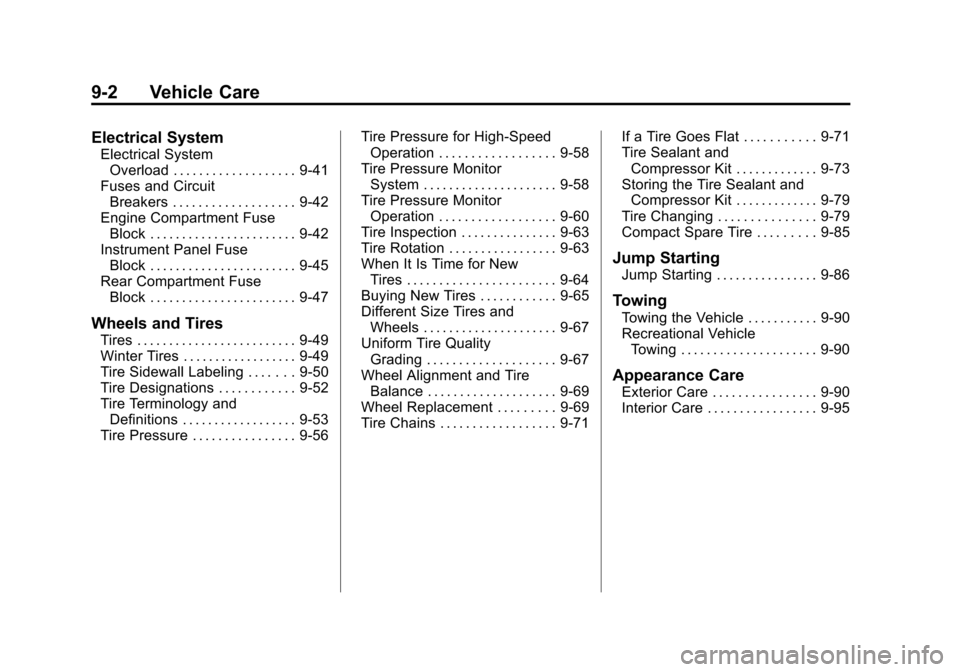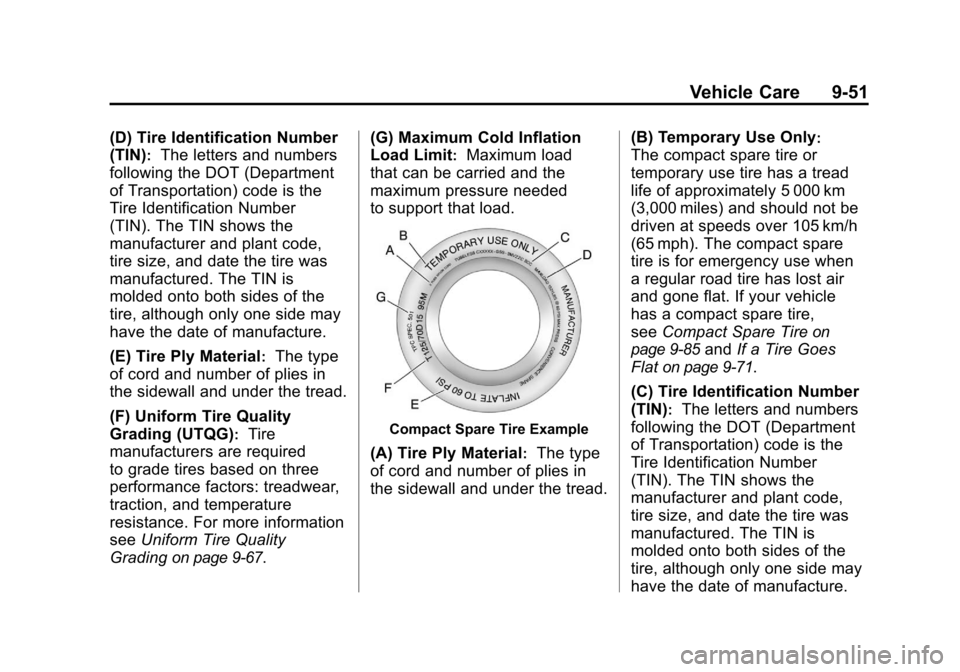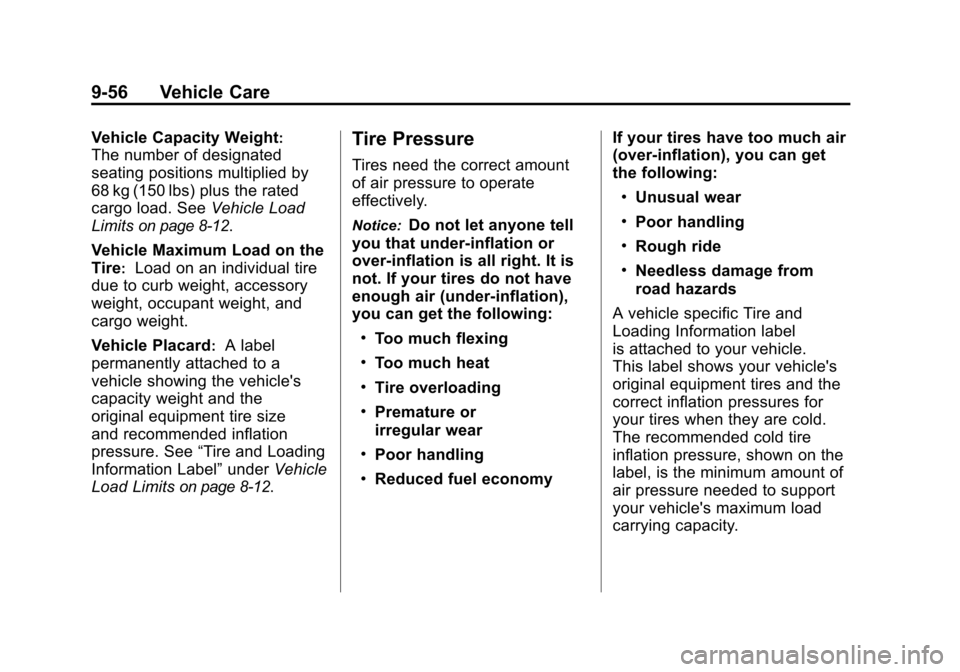2010 CHEVROLET CAMARO tire size
[x] Cancel search: tire sizePage 178 of 378

Black plate (2,1)Chevrolet Camaro Owner Manual - 2010
8-2 Driving and Operating
Fuel
Fuel . . . . . . . . . . . . . . . . . . . . . . . . . 8-43
Recommended Fuel . . . . . . . . . 8-44
Gasoline Specifications . . . . . . 8-44
California FuelRequirements . . . . . . . . . . . . . . 8-45
Fuels in Foreign Countries . . . 8-45
Fuel Additives . . . . . . . . . . . . . . . 8-45
Filling the Tank . . . . . . . . . . . . . . 8-46
Filling a Portable Fuel Container . . . . . . . . . . . . . . . . . . . 8-48
Towing
General TowingInformation . . . . . . . . . . . . . . . . . 8-48
Driving Characteristics and Towing Tips . . . . . . . . . . . . . . . . 8-49
Trailer Towing . . . . . . . . . . . . . . . . 8-53
Towing Equipment . . . . . . . . . . . 8-55
Conversions and Add-Ons
Add-On Electrical
Equipment . . . . . . . . . . . . . . . . . 8-55
Driving Information
Driving for Better Fuel
Economy
Driving habits can affect fuel
mileage. Here are some driving
tips to get the best fuel economy
possible.
.Avoid fast starts and accelerate
smoothly.
.Brake gradually and avoid
abrupt stops.
.Avoid idling the engine for long
periods of time.
.When road and weather
conditions are appropriate,
use cruise control, if equipped.
.Always follow posted speed
limits or drive more slowly when
conditions require.
.Keep vehicle tires properly
inflated.
.Combine several trips into a
single trip.
.Replace the vehicle's tires with
the same TPC Spec number
molded into the tire's sidewall
near the size.
.Follow recommended scheduled
maintenance.
Page 189 of 378

Black plate (13,1)Chevrolet Camaro Owner Manual - 2010
Driving and Operating 8-13
WARNING (Continued)
the way the vehicle handles.
These could cause you to
lose control and crash. Also,
overloading can shorten the
life of the vehicle.
Tire and Loading Information
Label
Label Example
A vehicle specific Tire and
Loading Information label is
attached to the vehicle's center pillar (B-pillar). With the driver's
door open, you will find the label
attached below the door lock
post. The Tire and Loading
Information label shows the
number of occupant seating
positions (A), and the maximum
vehicle capacity weight (B) in
kilograms and pounds.
The Tire and Loading
Information label also shows
the tire size of the original
equipment tires (C) and the
recommended cold tire inflation
pressures (D). For more
information on tires and inflation
see
Tires
on page 9‑49and
Tire Pressure
on page 9‑56.
There is also important loading
information on the Certification
label. It tells you the Gross
Vehicle Weight Rating (GVWR)
and the Gross Axle Weight Rating (GAWR) for the front and
rear axle. See
“Certification
Label” later in this section.
Steps for Determining Correct
Load Limit
1.Locate the statement
“The combined weight of
occupants and cargo should
never exceed XXX kg or
XXX lbs” on your vehicle's
placard.
2.Determine the combined
weight of the driver and
passengers that will be
riding in your vehicle.
3.Subtract the combined
weight of the driver and
passengers from XXX kg
or XXX lbs.
Page 234 of 378

Black plate (2,1)Chevrolet Camaro Owner Manual - 2010
9-2 Vehicle Care
Electrical System
Electrical SystemOverload . . . . . . . . . . . . . . . . . . . 9-41
Fuses and Circuit Breakers . . . . . . . . . . . . . . . . . . . 9-42
Engine Compartment Fuse
Block . . . . . . . . . . . . . . . . . . . . . . . 9-42
Instrument Panel Fuse Block . . . . . . . . . . . . . . . . . . . . . . . 9-45
Rear Compartment Fuse Block . . . . . . . . . . . . . . . . . . . . . . . 9-47
Wheels and Tires
Tires . . . . . . . . . . . . . . . . . . . . . . . . . 9-49
Winter Tires . . . . . . . . . . . . . . . . . . 9-49
Tire Sidewall Labeling . . . . . . . 9-50
Tire Designations . . . . . . . . . . . . 9-52
Tire Terminology andDefinitions . . . . . . . . . . . . . . . . . . 9-53
Tire Pressure . . . . . . . . . . . . . . . . 9-56 Tire Pressure for High-Speed
Operation . . . . . . . . . . . . . . . . . . 9-58
Tire Pressure Monitor System . . . . . . . . . . . . . . . . . . . . . 9-58
Tire Pressure Monitor
Operation . . . . . . . . . . . . . . . . . . 9-60
Tire Inspection . . . . . . . . . . . . . . . 9-63
Tire Rotation . . . . . . . . . . . . . . . . . 9-63
When It Is Time for New Tires . . . . . . . . . . . . . . . . . . . . . . . 9-64
Buying New Tires . . . . . . . . . . . . 9-65
Different Size Tires and Wheels . . . . . . . . . . . . . . . . . . . . . 9-67
Uniform Tire Quality Grading . . . . . . . . . . . . . . . . . . . . 9-67
Wheel Alignment and Tire Balance . . . . . . . . . . . . . . . . . . . . 9-69
Wheel Replacement . . . . . . . . . 9-69
Tire Chains . . . . . . . . . . . . . . . . . . 9-71 If a Tire Goes Flat . . . . . . . . . . . 9-71
Tire Sealant and
Compressor Kit . . . . . . . . . . . . . 9-73
Storing the Tire Sealant and Compressor Kit . . . . . . . . . . . . . 9-79
Tire Changing . . . . . . . . . . . . . . . 9-79
Compact Spare Tire . . . . . . . . . 9-85
Jump Starting
Jump Starting . . . . . . . . . . . . . . . . 9-86
Towing
Towing the Vehicle . . . . . . . . . . . 9-90
Recreational Vehicle Towing . . . . . . . . . . . . . . . . . . . . . 9-90
Appearance Care
Exterior Care . . . . . . . . . . . . . . . . 9-90
Interior Care . . . . . . . . . . . . . . . . . 9-95
Page 282 of 378

Black plate (50,1)Chevrolet Camaro Owner Manual - 2010
9-50 Vehicle Care
If you choose to use winter tires:
.Use tires of the same brand and
tread type on all four wheel
positions.
.Use only radial ply tires of the
same size, load range, and
speed rating as the original
equipment tires.
Winter tires with the same speed
rating as your original equipment
tires may not be available for H, V,
W, Y, and ZR speed rated tires.
If you choose winter tires with a
lower speed rating, never exceed
the tire's maximum speed capability.
Tire Sidewall Labeling
Useful information about a
tire is molded into its sidewall.
The examples below show a
typical passenger vehicle tire
and a compact spare tire
sidewall.
Passenger (P‐Metric) Tire Example
(A) Tire Size:The tire size is
a combination of letters and
numbers used to define a
particular tire's width, height, aspect ratio, construction type,
and service description. See the
“Tire Size”
illustration later in this
section for more detail.
(B) TPC Spec (Tire
Performance Criteria
Specification)
:Original
equipment tires designed to
GM's specific tire performance
criteria have a TPC specification
code molded onto the sidewall.
GM's TPC specifications meet
or exceed all federal safety
guidelines.
(C) DOT (Department of
Transportation)
:The
Department of Transportation
(DOT) code indicates that
the tire is in compliance
with the U.S. Department of
Transportation Motor Vehicle
Safety Standards.
Page 283 of 378

Black plate (51,1)Chevrolet Camaro Owner Manual - 2010
Vehicle Care 9-51
(D) Tire Identification Number
(TIN)
:The letters and numbers
following the DOT (Department
of Transportation) code is the
Tire Identification Number
(TIN). The TIN shows the
manufacturer and plant code,
tire size, and date the tire was
manufactured. The TIN is
molded onto both sides of the
tire, although only one side may
have the date of manufacture.
(E) Tire Ply Material
:The type
of cord and number of plies in
the sidewall and under the tread.
(F) Uniform Tire Quality
Grading (UTQG)
:Tire
manufacturers are required
to grade tires based on three
performance factors: treadwear,
traction, and temperature
resistance. For more information
see Uniform Tire Quality
Grading
on page 9‑67. (G) Maximum Cold Inflation
Load Limit
:Maximum load
that can be carried and the
maximum pressure needed
to support that load.
Compact Spare Tire Example
(A) Tire Ply Material:The type
of cord and number of plies in
the sidewall and under the tread. (B) Temporary Use Only
:
The compact spare tire or
temporary use tire has a tread
life of approximately 5 000 km
(3,000 miles) and should not be
driven at speeds over 105 km/h
(65 mph). The compact spare
tire is for emergency use when
a regular road tire has lost air
and gone flat. If your vehicle
has a compact spare tire,
see
Compact Spare Tire
on
page 9‑85
and If a Tire Goes
Flat
on page 9‑71.
(C) Tire Identification Number
(TIN)
:The letters and numbers
following the DOT (Department
of Transportation) code is the
Tire Identification Number
(TIN). The TIN shows the
manufacturer and plant code,
tire size, and date the tire was
manufactured. The TIN is
molded onto both sides of the
tire, although only one side may
have the date of manufacture.
Page 284 of 378

Black plate (52,1)Chevrolet Camaro Owner Manual - 2010
9-52 Vehicle Care
(D) Maximum Cold Inflation
Load Limit
:Maximum load
that can be carried and the
maximum pressure needed
to support that load.
(E) Tire Inflation
:The
temporary use tire or compact
spare tire should be inflated
to 420 kPa (60 psi). For more
information on tire pressure and
inflation see Tire Pressure
on
page 9‑56
.
(F) Tire Size
:A combination of
letters and numbers define a
tire's width, height, aspect ratio,
construction type, and service
description. The letter T as the
first character in the tire size
means the tire is for temporary
use only.
(G) TPC Spec (Tire
Performance Criteria
Specification)
:Original
equipment tires designed to
GM's specific tire performance criteria have a TPC specification
code molded onto the sidewall.
GM's TPC specifications meet
or exceed all federal safety
guidelines.
Tire Designations
Tire Size
The following illustration
shows an example of a typical
passenger vehicle tire size.
(A) Passenger (P‐Metric) Tire:
The United States version of a
metric tire sizing system. The
letter P as the first character in
the tire size means a passenger
vehicle tire engineered to
standards set by the U.S.
Tire and Rim Association.(B) Tire Width
:The three‐digit
number indicates the tire section
width in millimeters from
sidewall to sidewall.
(C) Aspect Ratio
:A two‐digit
number that indicates the tire
height‐to‐width measurements.
For example, if the tire size
aspect ratio is 60, as shown in
item C of the illustration, it would
mean that the tire's sidewall is
60 percent as high as it is wide.
(D) Construction Code
:A
letter code is used to indicate
the type of ply construction in
the tire. The letter R means
radial ply construction; the
letter D means diagonal or
bias ply construction; and the
letter B means belted‐bias ply
construction.
(E) Rim Diameter
:Diameter of
the wheel in inches.
Page 288 of 378

Black plate (56,1)Chevrolet Camaro Owner Manual - 2010
9-56 Vehicle Care
Vehicle Capacity Weight:
The number of designated
seating positions multiplied by
68 kg (150 lbs) plus the rated
cargo load. SeeVehicle Load
Limits
on page 8‑12.
Vehicle Maximum Load on the
Tire
:Load on an individual tire
due to curb weight, accessory
weight, occupant weight, and
cargo weight.
Vehicle Placard
:A label
permanently attached to a
vehicle showing the vehicle's
capacity weight and the
original equipment tire size
and recommended inflation
pressure. See “Tire and Loading
Information Label” underVehicle
Load Limits
on page 8‑12.
Tire Pressure
Tires need the correct amount
of air pressure to operate
effectively.
Notice:Do not let anyone tell
you that under‐inflation or
over‐inflation is all right. It is
not. If your tires do not have
enough air (under‐inflation),
you can get the following:
.Too much flexing
.Too much heat
.Tire overloading
.Premature or
irregular wear
.Poor handling
.Reduced fuel economy If your tires have too much air
(over‐inflation), you can get
the following:
.Unusual wear
.Poor handling
.Rough ride
.Needless damage from
road hazards
A vehicle specific Tire and
Loading Information label
is attached to your vehicle.
This label shows your vehicle's
original equipment tires and the
correct inflation pressures for
your tires when they are cold.
The recommended cold tire
inflation pressure, shown on the
label, is the minimum amount of
air pressure needed to support
your vehicle's maximum load
carrying capacity.
Page 290 of 378

Black plate (58,1)Chevrolet Camaro Owner Manual - 2010
9-58 Vehicle Care
Tire Pressure for
High-Speed Operation
{WARNING
Driving at high speeds, 160 km/h
(100 mph) or higher, puts an
additional strain on tires.
Sustained high-speed driving
causes excessive heat build up
and can cause sudden tire failure.
You could have a crash and you
or others could be killed. Some
high-speed rated tires require
inflation pressure adjustment for
high speed operation. When
speed limits and road conditions
are such that a vehicle can be
driven at high speeds, make sure
the tires are rated for high speed
operation, in excellent condition,
and set to the correct cold tire
inflation pressure for the
vehicle load.Vehicles with 245/45ZR20 103Y,
P245/50ZR19 104W and
275/40ZR20 106Y size tires,
have tires capable of high speed
use. Make sure the tires are inflated
to the recommended cold inflation
pressures before operating the
vehicle at speeds over 100 mph
(160 km/h). See
Vehicle Load Limits
on page 8‑12andTire Pressureon
page 9‑56.
When you end this high-speed
driving, return the tires to the cold
inflation pressure shown on the Tire
and Loading Information label. See
Vehicle Load Limits
on page 8‑12and Tire Pressure on page 9‑56.
Tire Pressure Monitor
System
The Tire Pressure Monitor System
(TPMS) uses radio and sensor
technology to check tire pressure
levels. The TPMS sensors monitor
the air pressure in your vehicle's
tires and transmit tire pressure
readings to a receiver located in
the vehicle.
Each tire, including the spare
(if provided), should be checked
monthly when cold and inflated to
the inflation pressure recommended
by the vehicle manufacturer on the
vehicle placard or tire inflation
pressure label. (If your vehicle has
tires of a different size than the size
indicated on the vehicle placard or
tire inflation pressure label, you
should determine the proper tire
inflation pressure for those tires.)